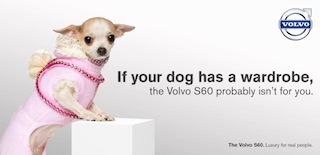Register by Jan 13 to save on passes and connect with marketers from Uber, Bose and more

Social media has quickly shifted from a nice-to-have to a must-have for marketers. That’s why brands like Volvo are increasingly dedicating more resources to fostering growth in this channel.
Volvo handles the majority of its social media in-house. In fact, the company increased its social media budget this year, emphasizing the power of the medium for its brand, according to Tassos Panas, CMO of Volvo. The car company is finding growing importance in social media, as it is a form of word-of-mouth marketing and views social as an the early test bed for the rest of its marketing.
How are you organizing for social media?
We handle the day-to-day stuff in-house, with a team of 3.5 people. One person is on the product side and spends half of his time interacting with fans that have product-related inquiries. We also use Cake Group on a project basis. The fact that we handle the majority of what we are doing in social in-house is a testament to how serious we are about social media. Our social media team is able to get up and walk over to the customer service team to figure out how to properly address a customer service inquiry. Our social media team is also our social media center of excellence team in that they are constantly evaluating new technology and opportunities. I’d say that, thanks to them, we have become more daring on the social media side. We’ve been taking more risks.
 Can you give a few examples of risks you’ve taken?
Can you give a few examples of risks you’ve taken?
In our most recent campaign, we, along with our AOR Arnold Worldwide, were trying to be more bold and polarizing by comparing Volvo to other luxury cars in the market. So the campaign is having fun with the traditional luxury stereotypes. We created one banner ad that brought this idea to life, so we thought. The ad features a Chihuahua in a dress, and the copy says, “If your dog has a wardrobe, then a Volvo is not for you.” We thought it was hilarious but were really surprised when 50 percent of our fans thought we crossed the line. Apparently, dressing up your dog has become more mainstream. We were actually planning to create a billboard based on this banner and decided not to based on the feedback. I will also tell you that our budget this year did go up 40 percent for digital and social media combined, which is a big increase. And I foresee these budgets will continue to go up, both for human and financial resources.
Social media managers often lament a lack of budget. What are two things that need to be improved in social media to attract more brand spending?
Volvo, like every company, struggles to find more budget to do innovative things. But social is still a new area and it is still evolving. That’s why it doesn’t get a fair share yet. I think as the social fan bases increase to bigger proportions, and the levels of interactions do as well, marketers will start putting more money behind social media. Another reason marketers aren’t putting enough money behind social media is that it is hard to measure. Obviously, we want to engage people who are Volvo enthusiasts and we definitely get that the value of word-of-mouth is tremendous. We would not invest 3.5 people if we did not feel that way. But having said that, it is hard to quantify what social means to the bottom line of our business.
I was recently at an event where Adobe’s CMO said that CMOs are afraid of data. Are you afraid of data?
I am a mechanical engineer by training. I’m a quantitative person. I enjoy data, and I may be the exception. But you have to be quantitative to be a CMO in today’s environment. Organizations need to have data-driven feedback systems. Volvo is currently working on improving the data flow within the organization. You can say goodbye to weekly and monthly analytics reports. We are looking to implement a dashboard for the team to use daily, with live data so that we can adjust quickly to the environment.
If you had all of the brand managers from the world’s largest brands in one room and you could give them one piece of advice pertaining to social media, what would it be?
I would say impressions aren’t everything. The quality of the impact, the story you’re telling, and how impactful it is deserves more attention than the impressions. Think about quality first and then determine how you want to get that story out. Too often, marketers are putting less emphasis on the quality of the story.
More in Marketing

OpenAI’s countdown: monetization, ads, and a Google-shaped threat
With fierce competition from Google et al, the clock is ticking for the AI company to launch its ad business.

Crisis, culture and costs: The new reality of the modern CMO
Crisis, culture and cost pressures are reshaping the modern CMO into a revenue-driven strategist uniting marketing, communications and finance.

Digiday+ Research: The marketer’s guide to AI applications, agentic AI, AI search and GEO/AEO in 2026
Digiday’s annual AI report explores how marketers are navigating the opportunities and challenges AI brings as it becomes an indispensable piece in their toolkits.






